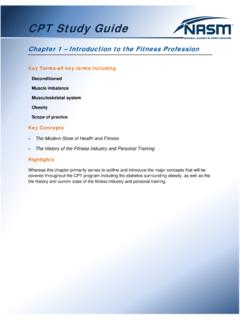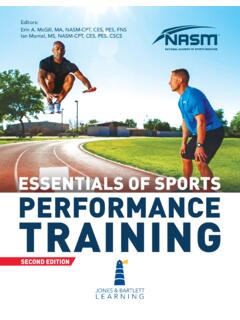Transcription of NASM-CPT APPROVED REFERENCES
1 UPDATED: APPROVED REFERENCESPRIMARY REFERENCES :1. NASM Essentials of Personal Fitness Training, 6th Edition2. NASM Essentials of Personal Fitness Training, 5th Edition3. ACSM s Resource for Personal Trainers, 4th Edition4. ACE Personal Trainer Manual, 4th Edition5. Trail Guide to the Body, 5th Edition (Biel)6. The Fundamentals for the Certified Personal Trainer, 6th Edition (NFPT)7. Essentials of Strength Training and Coordinating, 4th EditionSECONDARY REFERENCES :1. Nutrition, 5th Edition (Insel, Ross, McMahon, Bernstein)2. Atlas of Human Anatomy, 6th Edition (Netter)3. Movement: Functional Movement Systems: Screening, Assessment, Corrective Strategies (Cook)4. Anatomy and Physiology for Health & Physiology, 2e Jahangir Moini ISBN: 97812840369475. ACSM s Guidelines for Exercise Testing and Prescription, 9th, 9781609136055 6. ACSM s Exercise Management for Persons with Chronic Diseases and Disabilities ISBN 97807360743397.
2 Exercise Technique Manual for Resistance Training, 2nd ISBN: 97807360712778. Lifestyle Wellness Coaching, Gavin; ISBN: 97814504148459. Start Your Own Personal Training Business, ISBN: 978159918426510. ACSM s Health/Fitness Facility Standards and Guidelines, ACSM, ISBN: 978073605153811. NASM Behavior Change, online onlyUPDATED: AGGREGATE SCORE INFORMATIONDATES OF REPORT: JANUARY 1, 2015 DECEMBER 31, 2015 TOTAL OF NASM-CPT EXAM CANDIDATES:EXAMTOTALPASSINGFAILINGPASSIN G PERCENTNASM-CPT22,26614,9457,32167%UPDAT ED: nasm cpt EXAM BLUEPRINTThe national academy of sports medicine (NASM) contracted with Professional Examination Service (ProExam) to conduct a practice analysis of Certified Personal Trainers (CPTs) in practice analysis study defines the current knowledge, skills and abilities that must be demonstrated by entry-level credential holders to safely and successfully practice. This study also serves as the blueprint for determining the content (performance domains) for the certification exam(s).
3 PERFORMANCE DOMAINS AS VALIDATED BY THE 2015 JOB ANALYSIS STUDY INCLUDE THE INFORMATION BELOW:Domain 1: Basic and Applied Sciences and Nutritional Concepts 17%Domain 2: Assessment 18%Domain 3: Program Design 21%Domain 4: Exercise Technique and Training Instruction 22%Domain 5: Client Relations and Behavioral Coaching 12%Domain 6: Professional Development and Responsibility 10%DOMAIN 1: BASIC AND APPLIED SCIENCES AND NUTRITIONAL CONCEPTSKNOWLEDGE OF: K1. Concepts and structures of anatomy including nervous system, muscular system, skeletal system, cardiorespiratory system and endocrine systemK2. Functions of exercise physiology related to: a.
4 Nervous system b. muscular system c. skeletal system d. endocrine system e. cardiorespiratory system f. digestive system g. bioenergetics and exercise metabolismK3. Functional biomechanics (such as levers, force, torque)UPDATED: 1 Principles of human movement science (such as muscle action spectrum, force-couple relationships, length-tension relationships)K5. Principles of motor development (motor learning, motor control, motor behavior) K6. Macronutrients (carbohydrates, protein, fat) K7. Micronutrients (vitamins and minerals) K8. Hydration concepts K9. Recommendations and guidelines for caloric intake and expenditure K10. Units of energy measurement (Kcals/Calories)K11. Dietary reference intakesK12. Portion sizes, meal timing and frequency K13. Crash/fad/myth diets K14. Common nutritional supplements including possible risks, benefits, uses and effectsK15. Food and supplement label reading K16.
5 Factors that may influence weight management physiology (such as law of thermodynamics, poor sleep, endocrine abnormalities, medication) DOMAIN 2: ASSESSMENT TASKS1. Select, perform, document and interpret results of subjective assessments using tools and techniques such as questionnaires and interviews to assess client s medical history, needs and readiness for fitness program. 2. Select, perform, document, and interpret results of: a. Static postural assessments (such as assessment of upper and lower extremities and lumbo- pelvic-hip complex). b. Movement assessments (such as squat, gait, push/pull, single leg squat) in order to evaluate proper versus improper movement patterns. UPDATED: 2 c. Strength, muscular endurance, and power assessments (such as, 1-repetition maximum strength tests, push-up test, vertical jump test). d. Speed, agility, and quickness assessments (such as 40 yard dash, Pro shuttle, test).
6 E. Cardiorespiratory assessments (such as 3-minute Step Test, Rockport Walk Test, VO2 MAX Test). f. Physiological assessments (such as resting heart rate, and blood pressure).3. Select, perform, document, and interpret results of body composition assessments (such as Body Mass Index, skinfold, circumference measurements).KNOWLEDGE OF:K17. Physical Activity Readiness Questionnaire (PAR-Q) assessmentK18. Essential elements of personal, occupational, and family medical historyK19. Medical risk factors (such as previous injuries or surgeries, chronic pain, diseases, medications) K20. Elements of a lifestyle questionnaire (such as sleep, stress level, smoking, alcohol)K21. Cardiorespiratory assessments (such as 3-minute Step Test, Rockport Walk Test, VO2 MAX).K22. Physiological assessments relevant to CPTs (such as resting heart rate, blood pressure)K23. Kinetic chain checkpoints during static posture assessment (ankles, knees, lumbo-pelvic-hip complex, shoulders, head)K24.
7 Applicability of assessments from other health professionals (such as blood pressure, cholesterol, glucose) K25. Body composition assessments (such as skin fold calibers, circumference, bioelectrical impedance) K26. Performance assessments (such as 1-repetition maximum, vertical jump, long (broad) jump)K27. Types of movement assessments (such as Overhead Squat, Single-leg Squat, gait) K28. Body composition calculations (such as fat mass, lean mass, waist-to-hip ratio)K29. Considerations and modifications for performing assessments with special populations (such as seniors, youth, prenatal)K30. Standards for assessments and outcome expectations for special populations (such as youth, seniors, obese)K31. Indicators that client s condition is out of scope and requires referral K32. Criteria for reassessment (such as time lapsed, change in goals, lifestyle change) UPDATED: 3: PROGRAM DESIGN TASKS1.
8 Design client-specific program based on assessment results including: a. Flexibility training b. Resistance training c. Cardiorespiratory training d. Core training e. Balance training f. Plyometrics (reactive) training g. Speed Agility Quickness (SAQ) training 2. Design and apply program modifications as needed based on variables such as modalities, space, time, client abilities and current condition. KNOWLEDGE OF:K33. Flexibility training methods (such as self-myofascial release (SMR), static, active-isolated, and dynamic stretching)K34. Resistance training systems (such as single set, multiple set, super set, pyramid set, circuit training, vertical loading, horizontal loading)K35. Resistance training methods (such as stabilization, strength, power) and modalities (such as machines, body weight, free weights) K36. Cardiorespiratory training methods (such as zone/stage training, interval training, steady state) K37.
9 Core training methods for core-stabilization (such as plank, bird dog, bridge), core-strength (such as, reverse crunches, ball crunches, cable rotations) and core-power (such as soccer throw, rotation chest pass, medicine ball pullover throw)K38. Balance training methods for stabilization (such as single-leg balance, single-leg balance and reach, single-leg windmill) strength (such as single-leg squat, single-leg deadlift, lunge to balance) and power (such as single-leg box hop-up, single-leg box hop-down, multiplanar single-leg hop)K39. Proprioceptive manipulation (such as closing eyes, nodding head, single-leg stand)K40. Plyometric (reactive) training methods for stabilization(such as squat jump with stabilization, box jump-up to stabilization, multiplanar jumps with stabilization) strength (such as butt kicks, tuck jumps, squat jump) and power (such as Box run steps, ice skaters, proprioceptive plyometrics)UPDATED: 3 K41.
10 Speed Agility Quickness (SAQ) training methods (such as resisted sprints, cone drills, agility ladder drills) K42. Exercise progression/regression K43. General adaptation syndrome K44. Principle of specificity K45. Principle of overloadK46. Principle of variationK47. Periodization concepts (linear, undulating)K48. Acute variables (such as sets, repetitions, exercise selection, progressions, FITTE principle) K49. Risk vs. reward of different modalities and exercisesK50. Overtraining, rest, and recovery K51. Current trends (identification of) and their applicability to individual training programsK52. Types of fitness technology (such as heart rate monitors, performance trackers, calorie counters) and their uses and benefitsK53. Considerations for exercise program design for special populations (such as seniors, youth, prenatal)DOMAIN 4: EXERCISE TECHNIQUE AND TRAINING INSTRUCTIONTASKS1.









